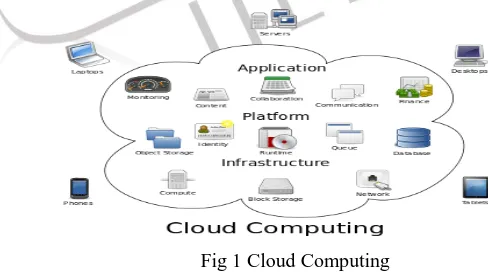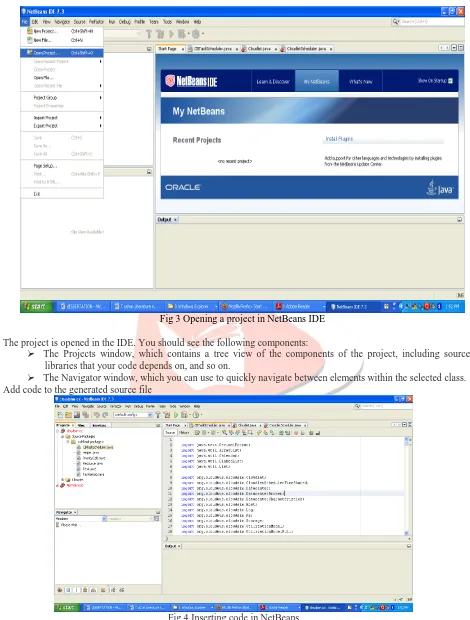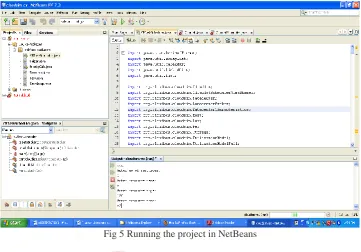IJEDR1403035
International Journal of Engineering Development and Research (www.ijedr.org)3112
Cost Based Algorithm Used In CloudSim
1Pooja Anand,
2Dr.Puneet Goswami
1M.tech Student, 2ProfessorGGITC, Ambala India
___________________________________________________________________________________________________
Abstract - In this paper introduces a more efficient algorithm for task scheduling based on Priority Based Scheduling in cloud computing and the implementation of it... Profit Based Task scheduling algorithm only takes the initial research on task scheduling in Cloud platform. However many issues remain open. Further improvement should be done to handle more complicated scenario involving dynamic factors such as dynamically changing cloud environment and other QoS attributes. The improvement of this algorithm should concentrate on discussing simultaneous instead of independent task scheduling in Cloud environment.
Index Terms - Cloud, Components, CloudSim, NetBeans
___________________________________________________________________________________________________ I. INTRODUCTION
A cloud is a type of parallel and distributed system consisting of inter-connected and virtualized computers that are dynamically provisioned and presented as one or more unified computing resources based on service level agreements established through negotiation between the service provider and consumers.
Cloud is a virtualized pool of computing resources .It can:
1. Manage a variety of different workload, including the batch of back-end operations and user oriented interactive applications.
2. Rapidly deploy and increase workload by speedy providing physical machines or virtual machines.
3. Support for redundancy, self-healing and highly scalable programming model, so that workload can be recover from a variety of inevitable hardware and software failure.
4. Real time monitor resources usage, rebalance the allocation of resources when needed.
Cloud computing is the use of computing resources (hardware and software) that are delivered as a service over a network (typically the Internet). It is the way to provide computer applications to users without the need for those to purchase, installs, or supports software on their personal computers and/or network. According to NIST “cloud computing is a model for enabling ubiquitous convenient on demand network
access to a shared pool of configurable computing resources (e.g. networks, servers, storage, applications, and service) that can be rapidly provisioned and released with minimal management efforts or service provider interaction” The name comes from the use of a cloud-shaped symbol as an abstraction for the complex infrastructure it contains in system diagrams. Cloud computing entrusts remote services with a user's data, software and computation.
Fig 1 Cloud Computing II. COMPONENTS OF CLOUD COMPUTING
Infrastructure as a Service (IaaS)
IJEDR1403035
International Journal of Engineering Development and Research (www.ijedr.org)3113
Software as a Service (SaaS)Software as a Service also operates on the virtualized and pay-per-use costing model whereby software applications are leased out to contracted organizations by specialized SaaS vendors. This is traditionally accessed remotely using a web browser via the Internet. The software has limited functionality and its core pack can be expanded and contracted allowing of easy customization which is billed accordingly. SaaS providers may host the software in their own data centers or with co-location providers, or may themselves be outsourced to IaaS providers. The availability of IaaS services is a key enabler of the SaaS model 10. Software as a service applications are accessed using web browsers over the Internet therefore web browser security is vitally important. Information security officers will need to consider various methods of securing SaaS applications. Web Services (WS) security, Extendable Markup Language (XML) encryption, Secure Socket Layer (SSL) and available options which are used in enforcing data protection transmitted over the Internet.
Platform as a Service (PaaS)
Platform as a service cloud layer works like IaaS but it provides an additional level of “rented” functionality. Clients using PaaS services transfer even more costs from capital investment to operational expenses but must acknowledge the additional constraints and possibly some degree of lock-in posed by the additional functionality layers [6]. The use of virtual machines act as a catalyst in the PaaS layer in Cloud computing. Virtual machines must be protected against malicious attacks such as cloud malware. Therefore maintaining the integrity of applications and well enforcing accurate authentication checks during the transfer of data across the entire networking channels is fundamental. Combining the three types of clouds with the delivery models we get a holistic cloud illustration as seen in Figure 1, surrounded by connectivity devices coupled with information security themes. Virtualized physical resources, virtualized infrastructure, as well as virtualized middleware platforms and business applications are being provided and consumed as services in the Cloud. Cloud vendors and clients’ need to maintain Cloud computing security at all interfaces.
III. RELATED WORK
Paul Martinaitis, Craig Patten and Andrew Wendelborn et 2009[3] Current activity in our project includes development of a template stream-aware scheduling component. The motivation for developing such a template as the basis for future work is that we need a more sophisticated mechanism than the default Grid bus round robin scheduler, which operates in a queue-oriented manner, iterating over the jobs in the queue. Such an arrangement is reasonable in the usual Grid bus environment, where jobs are independent. However, in a stream computation context, each job corresponds to a component which is almost certainly linked to at least one other component. It is therefore highly desirable that stream-aware schedulers are able to absorb the entire body of information regarding a stream.
Mrs.S.Selvarani, Dr.G.Sudha Sadhasivam et 2010[1] Cloud computing has been build upon the development of distributed computing, grid computing and virtualization. Since cost of each task in cloud resources is different with one another, scheduling of user tasks in cloud is not the same as in traditional scheduling methods. The objective of this paper is to schedule task groups in cloud computing platform, where resources have different resource costs and computation performance. Due to job grouping, communication of coarse-grained jobs and resources optimizes computation/communication ratio. For this purpose, an algorithm based on both costs with user task grouping is proposed. The proposed scheduling approach in cloud employs an improved cost-based scheduling algorithm for making efficient mapping of tasks to available resources in cloud. This scheduling algorithm measures both resource cost and computation performance, it also improves the computation/communication ratio by grouping the user tasks according to a particular cloud resource’s processing capability and sends the grouped jobs to the resource.
QI CAO, ZHI-BO WEI, WEN-MAO GONG et 2009[8] In cloud computing, traditional way for task scheduling cannot measure the cost of cloud resources accurately by reason that each of the tasks on cloud systems is totally different between each other. There may be no relationship between the overhead application base and the way that different tasks cause overhead costs of resources in cloud systems. The traditional way for task scheduling cannot meet the cloud market well enough. Introduces an optimized algorithm for task scheduling based on ABC (Activity Based Costing) in cloud computing and its implementation. Compared with the traditional methods of task scheduling, a new method with an optimized algorithm based on ABC algorithm
Traditional way for task scheduling in cloud computing tended to use the direct tasks of users as the overhead application base. There are some problems with it. This problem leads to over-costed and over-priced in some high-volume simple tasks while under-costed and under-priced in low-volume complex ones. Activity-based costing is a way of measuring both the cost of the objects and the performances of activities and it can measure the cost more accurate than traditional ones in cloud computing
IJEDR1403035
International Journal of Engineering Development and Research (www.ijedr.org)3114
to achieve on average up to 30% of energy savings in comparison based scheduling policies leading to higher profit and less carbon emissions.IV. PURPOSED ALGORITHM
In cloud computing, each application of users will run on a virtual operation system, the cloud systems distributed resources among these virtual operation systems. Every application is completely different and is independent and has no link between each other whatsoever, for example, some require more CPU time to compute complex task, and some others may need more memory to store data, etc. Resources are sacrificed on activities performed on each individual unit of service.
In order to measure direct costs of applications, every individual use of resources (like CPU cost, memory cost, I/O cost, etc.) must be measured. When the direct data of each individual resources cost has been measured, more accurate cost and profit analysis based on it than those of the traditional way can be got.
Cost of every individual resources use is different. The priority level can be sorted by the ratio of task’s cost to its profit. For easy management, three lists can be built for the sorted task, each list has a label of priority level such as HIGH, MID and LOW. Cloud systems can take someone out from the highest priority list to compute. Maps should be scanned every turn to modify the priority level of each task. Some restrictive conditions like maximum time user can wait should to be measured as extra factors. Parameters are defined as followed:
- Ri,k: The ith individual use of resources by the kth task.
- Ci,k: The cost of the ith individual use of resources by the kth task. - Pk: The profit earned from the kth task
- Lk: The priority level of the kth task.
The priority level of each task can be calculate as in formula (1), the total individual resources use is supposed to be n, so the priority level of the kth task is
LK = ∑ Ri,k × Ci,k /PK
Tool Used
NetBeans is an Integrated Development Environment (IDE) for developing primarily with Java, but also with other languages, in particular PHP, C/C++, and HTML 5.0. It is also an application platform framework for Java desktop applications and others. The NetBeans IDE is written in Java and can run on Windows, OS X, Linux, Solaris and other platforms supporting a compatible JVM. The NetBeans Platform allows applications to be developed from a set of modular software components called modules. Applications based on the NetBeans Platform (including the NetBeans IDE itself) can be extended by third party developers. The NetBeans IDE bundle for Java SE contains what is needed to start developing NetBeans plugins and NetBeans Platform based applications; no additional SDK is required. Applications can install modules dynamically. Fig 2 shows NetBeans 7.3
Fig 2 NetBeans IDE 7.3 To create an IDE:
1. Start NetBeans IDE
IJEDR1403035
International Journal of Engineering Development and Research (www.ijedr.org)3115
Fig 3 Opening a project in NetBeans IDE3. The project is opened in the IDE. You should see the following components:
The Projects window, which contains a tree view of the components of the project, including source files, libraries that your code depends on, and so on.
The Navigator window, which you can use to quickly navigate between elements within the selected class. 4. Add code to the generated source file
IJEDR1403035
International Journal of Engineering Development and Research (www.ijedr.org)3116
Fig 5 Running the project in NetBeansV. CONCLUSION
In this paper introduces more efficient algorithm for task scheduling based on Priority Based Scheduling in cloud computing and the implementation of it. Compared with the traditional way of task scheduling, Profit based Task Scheduling method has its own advantages.
In this we discuss Task scheduling in cloud computing environment. By doing research and analysis of this problem, that aims at task scheduling with minimum total tasks completion time and minimum cost. CloudSim3.0.3 is employed to carry out and simulate the tasks assignment algorithm, and distributed task scheduling.
REFERENCES
[1]Mrs.S.Selvarani1, Dr.G.Sudha Sadhasivam” IMPROVED COST-BASED ALGORITHM FOR TASK SCHEDULING IN CLOUD COMPUTING”2010 IEEE.
[2]Buyya, Rajkumar; Chee Shin Yeo, Srikumar Venugopal. “Market-Oriented Cloud Computing: Vision, Hype, and Reality for Delivering IT Services as Computing Utilities”. Department of Computer Science and Software Engineering, University of Melbourne, Australia. pp. 9. Retrieved 2008.
[3]Paul Martinaitis, Craig Patten and Andrew Wendelborn “Remote Interaction and Scheduling Aspects of Cloud Based Streams”2009 IEEE.
[4]Praveen K. Gupta, Nitin Rakesh” Different Job Scheduling Methodologies for Web Application and Web Server in a Cloud Computing Environment”2010 IEEE Third International Conference on Emerging Trends in Engineering and Technology. [5]Saurabh Kumar Garg ; Chee Shin Yeo b,Arun Anandasivamc, Rajkumar Buyya “Energy-E_cient Scheduling of HPC
Applications in Cloud Computing Environments”2009 IEEE.
[6]Young Choon Lee1, Chen Wang2, Albert Y. Zomaya1, Bing Bing Zhou “Profit-driven Service Request Scheduling in Clouds” 2010 10th IEEE/ACM International Conference on Cluster, Cloud and Grid Computing
[7]Cesar G. Chaves, Daniel M. Batista, Nelson L. S. da Fonseca” Scheduling Grid Applications on Clouds” 2010 IEEE [8]QI CAO, ZHI-BO WEI, WEN-MAO GONG” An Optimized Algorithm for Task Scheduling Base On Activity Based
Costing in Cloud Computing”2009 IEEE.



